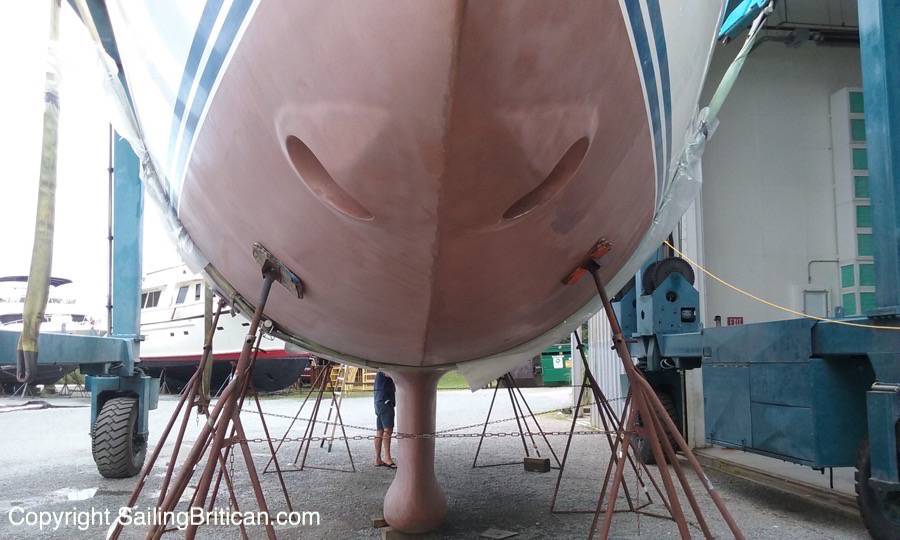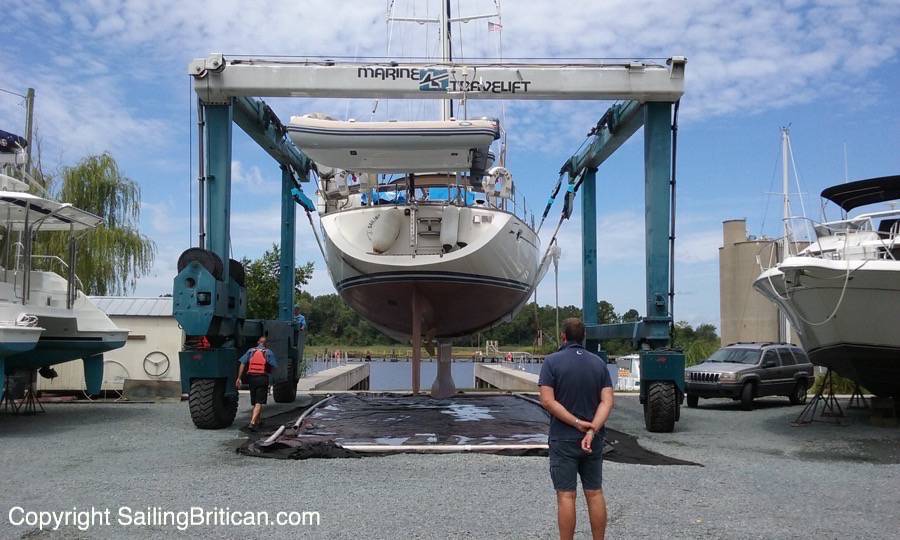This marks our first contact with both Bennett Brothers and CopperCoat Antifoul. Unfortunately, it was our first of two major CopperCoat Antifoul failure.
September 2016 – Our First Failed Application by Bennett Brothers in Wilmington, North Carolina.
You’ll benefit by watching this video:
- By seeing how to get to Bennett Brothers on the Cape Fear marina (not that we recommend this company). If you’re going to go there yourself it’s always nice to see what the set-up is so you know what to expect. There’s a bridge you have to go under while it opens. The crane area is right along the river. Once you enter the crane area there are two concrete jetties on either side and you have to throw lines to both sides.
- You’ll get some tips as to how to prepare your boat if you’re going to leave it for a while on the hard.
- We had issues getting our boat up high enough in the crane – the backstay and boom had to be relaxed.
- Around the 13 minute mark, you see what the boat looked like stripped back to the fiberglass hull and the process required to test the moisture level in the hull. Otherwise, I include a bit of information about being with my family and what we got up to.
CopperCoat Antifoul Failure – Our Original Application
CopperCoat Antifoul Failure – Background to why we went to North Carolina
My family and I had several reasons for sailing to America. The first reason was to escape the tropical hurricane season. Our insurance company requested that we sailed above the 30 North latitude line before the end of June. The 30 North line is roughly parallel to Jacksonville Florida.
Having family in North Carolina, only a couple states north of Florida, we decided to base ourselves in Wilmington, a city off the coast of North Carolina. We wanted to take a break from sailing, visit with family, and put our 6-year-old daughter, Sienna, into school for a term.
The video shows our haul-out at Bennett Brothers Yachts – in Wilmington N.C., footage of the CopperCoat antifoul process, what my family did while off the boat, work and trips we took to the boat while she was on the hard and finally, I have some clips showcasing Britican going back into the water.
If you’ve never taken a boat out of the water through the use of a crane this video will be helpful in that it demonstrates the process.
Furthermore, many readers on my various social media platforms have shown a large interest in CopperCoat. This video will show various images and clips of the stages Britican went through to get the job done.
While getting work done in Wilmington, North Carolina my husband, daughter, and I moved into my brother’s house in Cary, North Carolina. For six weeks we spent time with my brother and his family in addition to spending time with my mom and step-dad.
The work we had completed included a full rigging check with some repairs, new anodes for the bottom of the boat, getting one of our alternators fixed, some minor engine repairs, our bow thruster fixed, a new VHF radio installed (after our incident with the US Navy – read Sailing to Fort Lauderdale Florida (USVI to North Carolina) for that story.

Antifoul is needed to keep barnacles and other marine growth from growing.
Any growth on the bottom of a boat will drastically slow the boat down. Considering that sailboats are slow to begin with most sailors work hard to prevent growth.
Normal antifoul treatments last around a year or two whereas CopperCoat antifoul should last 8 to 10 years (if it’s not a CopperCoat antifoul failure). It’s very expensive but, in theory, a boat owner should save money in antifoul costs, labor, and haul out charges over the long run.

Plans changed!
Interestingly, and on par with our past experience, our plans had to be changed. The work on the boat went as scheduled however my plans to put our daughter, Sienna, into school in Wilmington did not.
The school districted to the marina in Wilmington is a rough inner-city school with several children with behavior issues. After enquiring about other schools and looking into private options nothing was working out.
Schools outside the district would not take a child that didn’t live there. Private schools cost the same amount as me hiring a full-time teacher to live on our boat! We had to look for other solutions.
My husband, Simon, and I traveled up and down the North Carolina coast. Either our boat wouldn’t fit into a marina (draft too deep or mast too high to pass under bridges) or the school district wasn’t a good one.
Our search led us to Charleston, South Carolina…
…one state below North Carolina and a four-hour drive from my family (Wilmington was a 2-hour drive).
One thing led to another and we found a marina that allows liveaboards and an excellent school. Although the distance between my family and our new home increased it was a no-brainer solution.
Never did I think I’d be living in Charleston, South Carolina. But then again, never did I think I’d buy a 56’ Oyster and sail the world 😉
So…the plan now is to chill out for a bit and allow Sienna to grasp the concept of education. Then do some cosmetic work on the boat (re-do the teak deck caulking, renew our ceiling lights, caulk our bathrooms, make new curtains, cockpit cushions and covers, and more.
Simon, Sienna, and I have been sailing for 2 ½ years. And we’ve been going non-stop for around 15 months without staying anywhere longer than a few weeks. After our 6-month wintering in Marina Di Ragusa in Sicily, we’ve been sailing the Med, the Atlantic, and the Caribbean.
But who knows what’s around the corner?! We certainly didn’t know that we were going through our first CopperCoat antifoul failure.
Here are the links to all our CopperCoat Problems Videos:
To get an overview of all our CopperCoat videos and articles please visit: CopperCoatAntifouling Review Otherwise, get more in-depth information below.
- September 2016 – Our First Failed Application by Bennett Brothers in Wilmington, North Carolina. Watch here: CopperCoat Antifoul Failure
- September 2017 – An Update On Our CopperCoat Results One Year Later. It didn’t work! Get the full CopperCoat antifouling review story, up to this point, by reading Our CopperCoat Antifoul Problems
- October 2017 – CopperCoat USA & Bennet Brothers Work To Rectify Our Issues. To see our boat hauled out in Charleston and the USA representative from CopperCoat inspect the hull, watch our sailing Vlog episode that covers our CopperCoat antifouling review entitled: Liveaboard Life
- July 2018 – Haul Out In Trinidad & Tobago – All The Patches Were Barnacle Free But the Rest of the Boat was Full of Barnacles! To view our haul out in Trinidad and get more information about the second failed application, watch the second video on our Trinidad & Tobago Destinations section entitled Haul Out Trinidad & Tobago.
- August 2019 – Evidence of our Failed Peake’s Boatyard Application and Attempted Sanding Touch-up in Antigua. And September 2019 – Arrangements for CopperCoat UK To Come To Grenada. You can see both the August and September 2019 videos here: CopperCoat Antifouling Solution
- November 2019 – Our Third & Final CopperCoat Antifoul Application by Mr. CopperCoat Himself. Watch here: CopperCoat Application
- June 2020 – The Results Of Our Third Full CopperCoat Application Are…?!?!?! Find out here: CopperCoat Problems
Tips To Avoid CopperCoat Problems
And make sure to read our article entitled: 7 CopperCoat Tips For A Successful Application
Any Questions or Comments?
Please leave them below.
We went with CopperCoat a year ago, and couldn’t be happier. Hopefully you guys enjoy yours as much as we do!
Great post Kim,
I look forward to hearing your thoughts on how the coppercoat performs. Roughly how much more expensive was it to do as opposed to regular antifoul?
Thanks heaps
Hey Viki – sorry I didn’t respond sooner. I missed your post. It’s massively more expensive. A normal antifoul is in the lower thousands. CopperCoat (for our boat) was around $12k (USD).